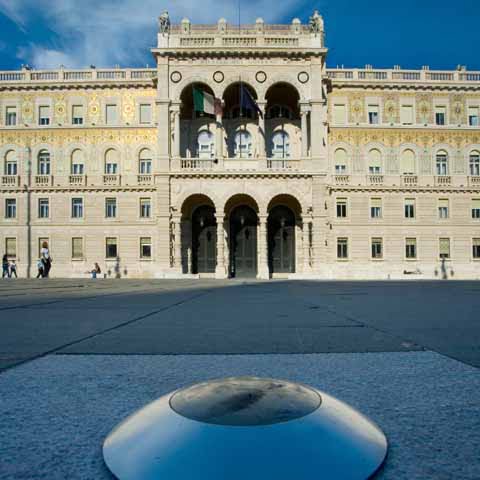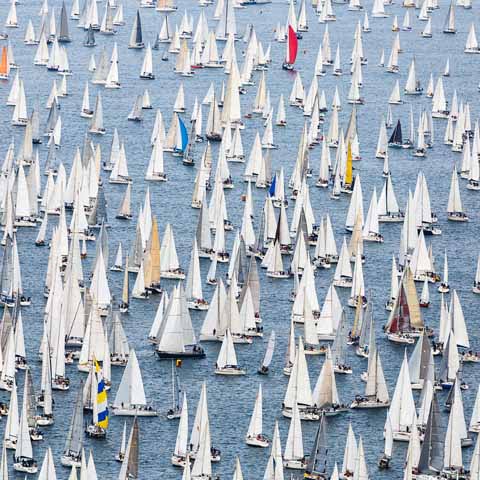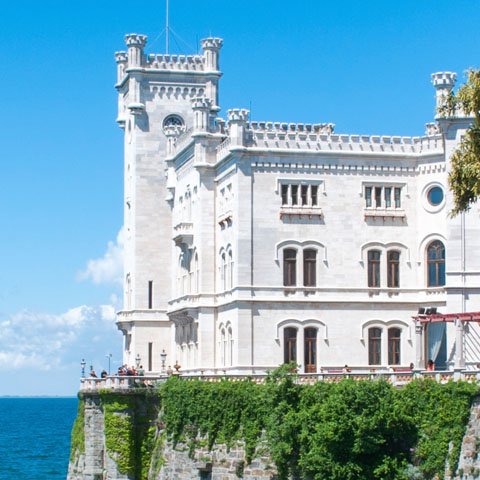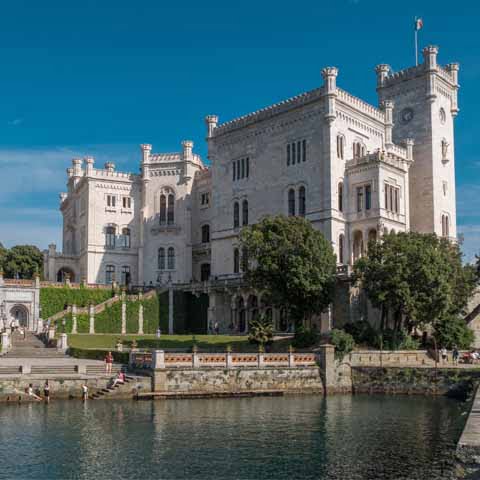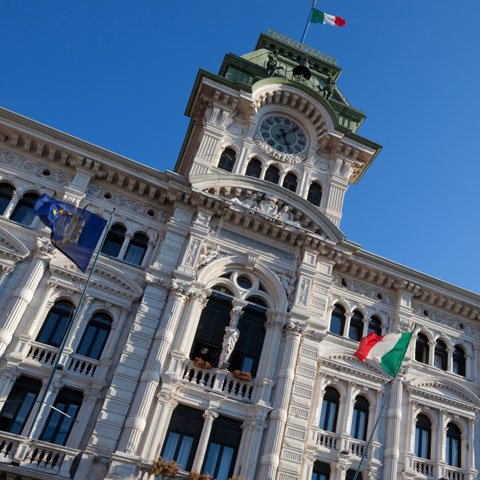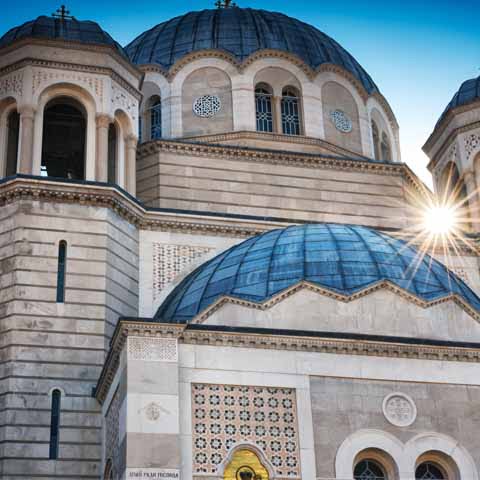The Northeastern Italian city of Trieste is brimming with activity from boating to sightseeing in the local piazze. Whether you choose to sip a superb cup of Trieste coffee while watching boats sail by in the Gulf of Trieste or take in the local culture by visiting historic churches and museums, slow the pace of your day and delight in all that the city has to offer.
FESTIVALS AND EVENTS
A popular annual event held in mid-January is the Trieste Film Festival. The event celebrates cinematic accomplishments and films. The event is best known for introducing the Italian public to less-acknowledged films and talent, new or old. The summer brings another festival which celebrates the best international short films and the works of early Italian filmmakers, called ShorTS.
Trieste is perhaps best known for the Barcolana Regatta. This international sailing event usually takes place on the second Sunday of October. With an estimated twenty-five thousand plus sailors entering the race and two hundred and fifty thousand spectators watching from the shore, there is no doubt that the Barcolana Regatta is one of the most exciting in the world. To behold the blue sparkling waters of the Gulf of Trieste full of brightly colored boats competing in the race, is a true delight that is not likely to be replicated anywhere else.
OUTDOOR
With Trieste being a key port in Northern Italy, spending some time touring the harbor is an absolute must. Always busy with sea vessels that are importing and exporting goods, the harbor is constantly buzzing with activity that is best enjoyed by sitting seaside or taking a guided boat tour. With ships and boats of literally all sizes, colors, and designs cruising through the waters, see how many types of water-based transportation you can spot and try to determine what might bring them to the port. Sailboats, fishing boats, and even luxurious yachts can be found in the waters by Piazza Venezia, the main harbor. With so many commercial shipping operations in the Port of Trieste, it is not unusual to see enormous cargo ships also headed toward the docks.
Molo Audace, formerly known as Molo San Carlo, is a Trieste pier that stretches more than eight hundred feet into the Adriatic Sea, offering simply spectacular views. The original pier was built in the mid-eighteenth century and was much shorter at only three hundred or so feet long. It was named after a ship, the San Carlo, which sank in the harbor. During this time, the pier was a popular docking spot for boats in the port. Over time the pier was gradually lengthened, and in the early twentieth century the pier was renamed Molo Audace after the first ship of the Italian Navy to reach Trieste. Today it is a favorite sightseeing spot for travelers. Depending on the viewpoint, Molo Audace offers stunning views of the quiet blue waters of the Adriatic Sea or breathtaking views of the Trieste shore.
Although Trieste is undoubtedly beautiful by day, the city truly sets the northeast coast of Italy aglow by night. From the time the sun begins to set behind the mountains, the city is bathed in a soft rosy hue that looks simply enchanting when seen from a bird’s eye view over the Gulf of Trieste. The Piazza Unità d’Italia is a beacon in the dark as the buildings of the square are lit up and create a charming atmosphere for locals and visitors taking a late evening stroll through the city’s historic center.
INDOOR
Along the Canal Grande is the Schmidl Museum Theater located in Palazzo Gopcevich. The museum archives the music and theater of Trieste from as early as the eighteenth century. Here you can find exhibits such as photographs, posters, jewelry, costumes, and autographed manuscripts. The museum has an entire section dedicated to musical instruments.
Also above the Canal Grande is the Church of San Spiridione of the Serbian Orthodox Christian community. The structure is more of a Byzantine Eastern style church, with the most defining characteristic being that of a large dome at the tallest point of the church. Take some time to wander inside the church and appreciate the intricate oil paintings and frescoes.
One of the most visited Catholic churches in Trieste is that of Sant’Antonio Taumaturgo which is sometimes referred to as Sant’Antonio Nuovo. It sits majestically at the end of the Canal Grande and is easily recognized by the gorgeous columns in the front of the structure. Above the columns are six statues that depict the Patron Saints of Trieste: Servulus, Justus, Maurus, Sergius, Thecla, and Euphemia. As exquisite as the exterior is, do not miss the interior of this single nave church which is home to some beautiful paintings.
Of course, travelers should also make a point to visit the Cathedral of San Giusto. The current structure is the result of a merger between two pre-existing churches. The cathedral is notable for its Romanesque and Gothic architectural elements, particularly the central rose window on the façade. The interior is decorated with beautiful Byzantine mosaics as well as a series of frescoes depicting events from the life of San Giusto.
A trip to Trieste, often called the city of coffee, would be a waste without visiting one of the coffeehouses lining the Canal Grande or the Gulf of Trieste. Many of the cafés are simply gorgeous, with intricate details and outstanding historic décor. In keeping with traditional Italian culture, plan to take some time to enjoy a coffee break during your sightseeing.
Art lovers should make a point to visit the Museo Revoltella, which is Trieste’s modern art gallery. Founded during the nineteenth century, the museum features an impressive collection of works from the nineteenth and twentieth centuries by local artists as well as Italian artists of national renown.
ACITIVITIES FOR FAMILY
Some of the most beautiful parts of Trieste are the number of outdoor piazze or city squares. With gorgeous majestic architecture, the buildings, fountains, and statues found in many of these squares add a unique charm to the historic areas. A must-see square is one of the largest seaside squares in all of Italy, Piazza Unità d’Italia. The square is lined with magnificently designed buildings on three sides and the Gulf of Trieste on the fourth. Visitors are often drawn to this square because of its beauty by day or night and the presence of historic statues and the famous Fountain of Four Continents. Some other Trieste city squares not to be missed include Piazza della Borsa, Piazza Sant’Antonio, and Piazza Ponterosso. Most of Trieste’s piazze are the place to be for strolling, mingling, enjoying a hot cup of coffee, and seasonal shopping and markets.
Not far from Piazza Unità d’Italia is the Canal Grande. This six-hundred-and-fifty-foot waterway was constructed in the eighteenth century and used by boats coming to Trieste to drop off cargo. When walking along the canal today, tourists should see the Ponte Russo, or Red Bridge, the only remaining original bridge of the canal. Be sure not to miss the statue of beloved author James Joyce that was added in the early twenty-first century and sits atop the bridge. Families may take a leisurely stroll along the length of the canal to take in the historic architecture of churches and cafés that line both sides. Mom and dad can enjoy a superb Trieste coffee while the kids count the dozens of colorful boats lining the canal. The peaceful waters of the Adriatic Sea are soothing to the soul and provide a great way for the family to unwind and relax.
ACTIVITIES FOR KIDS
Children are inexorably drawn to the beautiful princesses, gallant knights, and medieval castles that fairytales are made of. For this reason, take the children to visit Trieste’s Castle of San Giusto. The structure actually doubles as a fortress and now a museum. Though built centuries ago, the castle is in fabulous condition due primarily to the fact that it saw very little military action over the years, despite its design as a fortress. Kids will enjoy climbing the castle tower and letting their imagination go as they stand atop the grand castle facing the vast Adriatic Sea. Inside the castle is a museum that offers a complete history of the castle as well as some fascinating artifact exhibits.
Just outside the city limits are several more amazing castles the children will enjoy seeing. One of the more renowned is Miramare Castle, which sits directly on the rocky shore of the deep blue water of the Adriatic Sea. North of the city, this majestic castle and museum was once home to Archduke Maximilian of Austria. Some parts of the castle and grounds are open to visitors depending on the day and time. The beautiful park that surrounds the castle is the perfect place to spend an afternoon amid nature. Also not to be missed is the Duino Castle, which is still inhabited. The castle sits atop a picturesque rocky cliff that looks over the Gulf of Trieste. It is now open to the public on a limited basis as a museum and park.
Kids will be fascinated by news of a resident dinosaur! A dinosaur’s skeleton was found near the village of San Giovanni and is now located at the Civic Museum of Natural History in Trieste. The dinosaur has been lovingly nicknamed Antonio the Dinosaur of the Dolomite Mountains.
UNIQUE FOR TRIESTE
One of the more unusual features of the city is the remnants of the Trieste Roman Theater in the historic city center. The most recognizable feature is the Roman Amphitheater which is located on the Via del Teatro Romano. Most of the original seating and part of the main stage theater remain, along with several columns and partial walls. Today, the theater can hold several thousand in its audience and is home to periodic artistic and musical events throughout the year. Steal away to this historical structure and lose yourself in Trieste’s culture.
Nicknamed “The City of Coffee,” Trieste is known for its elegant coffee shops that were established during the second part of the eighteenth century. Due to Austrian influence, the coffee shops have a decidedly Viennese atmosphere. Many served as literary cafés and gave the city’s intellectuals and writers, such as James Joyce, Italo Svevo, and Umberto Saba, a place to gather and exchange ideas. When in Trieste, be sure to stop by one of the coffee shops for a dose of culture as well as coffee.
Thanks to numerous influences from other parts of Europe, Trieste is a cultural hub unlike any other in Italy. This beautiful city located along the Adriatic Sea offers plenty of opportunities for sightseeing as well as indulging in the local cuisine and excellent coffee at the literary cafés.
Travel Guides
The Friuli Venezia Giulia Region of Italy
The Cities of Friuli Venezia Giulia, Italy
